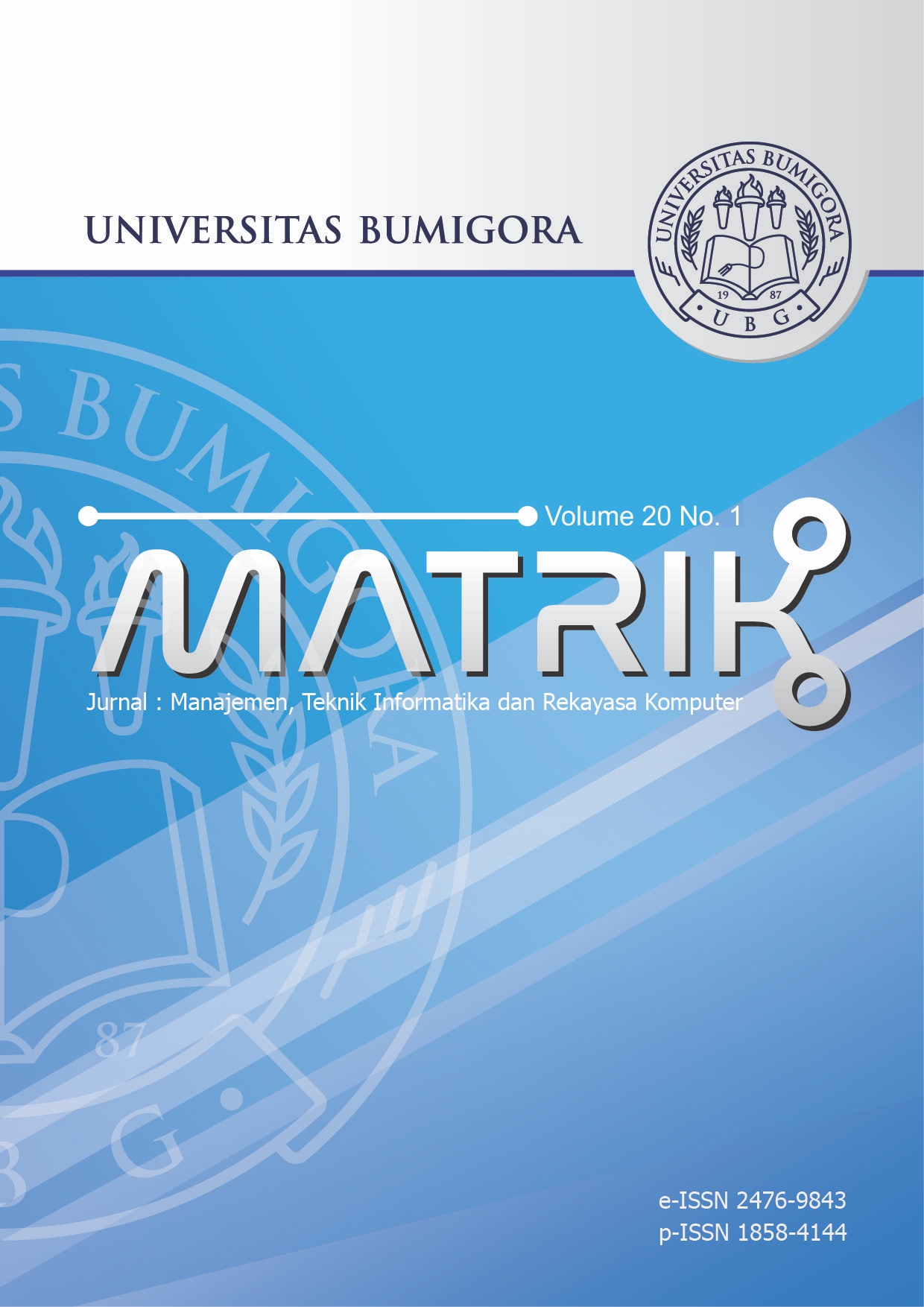Resilient Backpropagation Neural Network on Prediction of Poverty Levels in South Sulawesi
DOI:
https://doi.org/10.30812/matrik.v20i1.726Keywords:
Accuracy, Resilient Algorithm, Backpropagation Neural Network, Proverty Levels, PredictionAbstract
Poverty is a topic that continues and is always discussed up to this time, as a benchmark indicator of how the level of welfare and prosperity in the lives of people in a country. Several attempts have been made by the central and regional governments to reduce poverty levels, including “Bantuan Langsung Tunai†(BLT) and the “Program Keluarga Harapan†(PKH). However, poverty reduction in Indonesia is still slowing down, including in South Sulawesi. Based on this, this study aims to predict poverty levels in South Sulawesi. Factors thought to influence poverty levels are the Human Development Index (HDI), the Open Unemployment Rate (TPT), and the Gross Regional Domestic Product (GRDP). The data used are data from 2010 to 2014. The method used is a backpropagation neural network with a resilient algorithm or better known as a resilient backpropagation neural network (RBNN). The results of the prediction of poverty levels using predictors of HDI, TPT, and GRDP showed that the analysis of the RBNN reached its optimum using architecture [3- 9 - 1] and reached convergence at the 81th iteration with an accuracy rate of 95.34%.
Downloads
References
[2] Badan Pusat Statistik, Profil Kemiskinan di Indonesia September 2018. Jakarta: Badan Pusat Statistik, 2019.
[3] Badan Pusat Statistik Provinsi Sulawesi Selatan, Profil Kemiskinan Sulawesi Selatan, September 2018. Makassar: Badan Pusat Statistik Provinsi Sulawesi Selatan, 2019.
[4] N. Zuhdiyaty and D. Kaluge, “Analisis Faktor-Faktor yang Mempengaruhi Kemiskinan di Indonesia Selama Lima Tahun Terakhir (Studi Kasus pada 33 Provinsi),†Jurnal Ilmiah Bisnis dan Ekonomi Asia, vol. 11, no. 2, pp. 27–31, 2017.
[5] Y. C. Pratama, “Analisis Faktor-Faktor yang Mempengaruhi Kemiskinan di Indonesia,†Esensi: Jurnal Bisnis dan Manajemen, vol. 4, no. 2, Sep. 2014.
[6] A. N. Ulfah and S. ’Uyun, “Analisis Kinerja Algoritma Fuzzy C-Means dan K -Means pada Data Kemiskinan,†JATISI (Jurnal Teknik Informatika dan Sistem Informasi), vol. 1, no. 2, pp. 139–148, 2015.
[7] A. Mulyani, “Analisis Neural Network Struktur Backpropagation sebagai Metode Peramalan pada Perhitungan Tingkat Kemiskian di Indonesia,†Techno Nusa Mandiri, vol. 13, no. 1, pp. 9–15, 2016.
[8] S. Mamase and R. S. Sinukun, “Prediksi Tingkat Kemiskinan Provinsi Gorontalo dengan Metode GRNN,†in Seminar Nasional Humaniora & Aplikasi Teknologi Informasi 2018, 2018, pp. 29–32.
[9] L. M. Patnaik and K. Rajan, “Target Detection Through Image Processing and Resilient Propagation Algorithms,†Neurocomputing, vol. 35, no. 1–4, pp. 123–135, Nov. 2000.
[10] A. K. Santra, N. Chakraborty, and S. Sen, “Prediction of Heat Transfer Due to Presence of Copper–water Nanofluid Using Resilient-propagation Neural Network,†International Journal of Thermal Sciences, vol. 48, no. 7, pp. 1311–1318, Jul. 2009.
[11] L. M. Saini, “Peak Load Forecasting Using Bayesian Regularization, Resilient and Adaptive Backpropagation Learning Based Artificial Neural Networks,†Electric Power Systems Research, vol. 78, no. 7, pp. 1302–1310, Jul. 2008.
[12] S. Kumar and B. K. Tripathi, “High-Dimensional Information Processing Through Resilient Propagation in Quaternionic Domain,†Journal of Industrial Information Integration, vol. 11, pp. 41–49, Sep. 2018.
[13] R. P. Satya Hermanto, Suharjito, Diana, and A. Nugroho, “Waiting-Time Estimation in Bank Customer Queues using RPROP Neural Networks,†Procedia Computer Science, vol. 135, pp. 35–42, 2018.
[14] R. Y. Fa’rifah and Z. Busrah, “Backpropagation Neural Network untuk Optimasi Akurasi pada Prediksi Financial Distress Perusahaan,†Jurnal INSTEK (Informatika Sains dan Teknologi), vol. 2, no. 2, pp. 101–110, 2017.
[15] W. Watsuntorn, R. Khanongnuch, W. Chulalaksananukul, E. R. Rene, and P. N. L. Lens, “Resilient Performance of An Anoxic Biotrickling Filter for Hydrogen Sulphide Removal From A Biogas Mimic: Steady, Transient State and Neural Network Evaluation,†Journal of Cleaner Production, vol. 249, p. 119351, Mar. 2020.
 
[16] A. Poole and A. Kotsialos, “Second Order Macroscopic Traffic Flow Model Validation Using Automatic Differentiation with Resilient Backpropagation and Particle Swarm Optimisation Algorithms,†Transportation Research Part C: Emerging Technologies, vol. 71, pp. 356–381, Oct. 2016.
[17] M. Shiblee, B. Chandra, and P. K. Kalra, “Learning of Geometric Mean Neuron Model Using Resilient Propagation Algorithm,†Expert Systems with Applications, vol. 37, no. 12, pp. 7449–7455, Dec. 2010.
Downloads
Published
Issue
Section
How to Cite
Similar Articles
- Sri Suwarno, Erick Kurniawan, Multi-Level Pooling Model for Fingerprint-Based Gender Classification , MATRIK : Jurnal Manajemen, Teknik Informatika dan Rekayasa Komputer: Vol. 22 No. 2 (2023)
- Wilda Imama Sabilla, Mamluatul Hani'ah, Ariadi Retno Tri Hayati Ririd, Astrifidha Rahma Amalia, Proliferative Diabetic Retinopathy Detection Using Convolutional Neural Network with Enhanced Retinal Image , MATRIK : Jurnal Manajemen, Teknik Informatika dan Rekayasa Komputer: Vol. 25 No. 1 (2025)
- Achmad Lukman, Wahju Tjahjo Saputro, Erni Seniwati, Improving Performance Convolutional Neural Networks Using Modified Pooling Function , MATRIK : Jurnal Manajemen, Teknik Informatika dan Rekayasa Komputer: Vol. 23 No. 2 (2024)
- Tjut Awaliyah Zuraiyah, Sufiatul Maryana, Asep Kohar, Automatic Door Access Model Based on Face Recognition using Convolutional Neural Network , MATRIK : Jurnal Manajemen, Teknik Informatika dan Rekayasa Komputer: Vol. 22 No. 1 (2022)
- Helna Wardhana, I Made Yadi Dharma, Khairan Marzuki, Ibjan Syarif Hidayatullah, Implementation of Neural Machine Translation in Translating from Indonesian to Sasak Language , MATRIK : Jurnal Manajemen, Teknik Informatika dan Rekayasa Komputer: Vol. 23 No. 2 (2024)
- Willy Riyadi, Jasmir Jasmir, Performance Prediction of Airport Traffic Using LSTM and CNN-LSTM Models , MATRIK : Jurnal Manajemen, Teknik Informatika dan Rekayasa Komputer: Vol. 22 No. 3 (2023)
- Reo Wicaksono, Didik Dwi Prasetya, Ilham Ari Elbaith Zaeni, Nadindra Dwi Ariyanta, Tsukasa Hirashima, Machine Learning for Open-ended Concept Map Proposition Assessment: Impact of Length on Accuracy , MATRIK : Jurnal Manajemen, Teknik Informatika dan Rekayasa Komputer: Vol. 25 No. 1 (2025)
- Mochamad Wahyudi, Solikhun Solikhun, Lise Pujiastuti, Gerhard-Wilhelm Weber, New Approach K-Medoids Clustering Based on Chebyshev Distance with Quantum Computing for Anemia Prediction , MATRIK : Jurnal Manajemen, Teknik Informatika dan Rekayasa Komputer: Vol. 25 No. 1 (2025)
- Ni Wayan Sumartini Saraswati, I Wayan Dharma Suryawan, Ni Komang Tri Juniartini, I Dewa Made Krishna Muku, Poria Pirozmand, Weizhi Song, Recognizing Pneumonia Infection in Chest X-Ray Using Deep Learning , MATRIK : Jurnal Manajemen, Teknik Informatika dan Rekayasa Komputer: Vol. 23 No. 1 (2023)
- Arief Hermawan, Adityo Permana Wibowo, Akmal Setiawan Wijaya, The Improvement of Artificial Neural Network Accuracy Using Principle Component Analysis Approach , MATRIK : Jurnal Manajemen, Teknik Informatika dan Rekayasa Komputer: Vol. 22 No. 1 (2022)
You may also start an advanced similarity search for this article.
Most read articles by the same author(s)
- Suwardi Annas, Bobby Poerwanto, Sapriani Sapriani, Muhammad Fahmuddin S, Implementation of K-Means Clustering on Poverty Indicators in Indonesia , MATRIK : Jurnal Manajemen, Teknik Informatika dan Rekayasa Komputer: Vol. 21 No. 2 (2022)
- Bobby Poerwanto, Baso Ali, Implementasi Algoritma Fuzzy C-Means dalam Mengelompokkan Kecamatan di Tana Luwu Berdasarkan Produktifitas Hasil Perkebunan , MATRIK : Jurnal Manajemen, Teknik Informatika dan Rekayasa Komputer: Vol. 19 No. 1 (2019)


.png)












